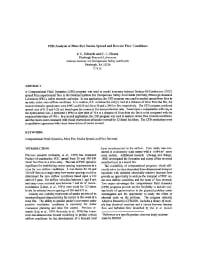Mining Publication: CFD Analysis of Mine Fire Smoke Spread and Reverse Flow Conditions
Original creation date: June 1999
Authors: JC Edwards, CC Hwang
NIOSHTIC2 Number: 20024905
Proc Eighth U.S. Mine Ventilation Symposium. Rolla, MO; University of Missouri-Rolla, Press, Rolla, Missouri, 1999 Jun; :417-422
A Computational Fluid Dynamics (CFD) program was used to model buoyancy induced Product-Of-Combustion (POC) spread from experimental fires in the National Institute for Occupational Safety and Health (NIOSH), Pittsburgh Research Laboratory (PRL), safety research coal mine. In one application, the CFD program was used to predict spread from fires in an entry under zero airflow conditions. At a location, 0.41 m below the entry's roof at a distance of 30 m from the fire, the measured smoke spread rates were 0.093 and 0.23 m/s for a 30 and a 296 kw fire, respectively. The CFD program predicted spread rates of 0.15 and 0.26 m/s based upon the measured fire heat production rates. Based upon a computation with c3h8 as the hydrocarbon fuel, a predicted 5 PPM co alert time of 70 s at a distance of 30 m from the fire is to be compared with the measured alert time of 148 s. In a second application, the CFD program was used to analyze smoke flow reversal conditions, and the results were compared with visual observations of smoke reversal for 12 diesel fuel fires. The CFD predictions were in qualitative agreement with visual observations of smoke reversal.

NIOSHTIC2 Number: 20024905
Proc Eighth U.S. Mine Ventilation Symposium. Rolla, MO; University of Missouri-Rolla, Press, Rolla, Missouri, 1999 Jun; :417-422
- Experimental and Modeling Investigation of the Effect of Ventilation on Smoke Rollback in a Mine Entry
- Experimental and Modeling Investigation of the Effect of Ventilation on Smoke Rollback in a Mine Entry
- Fire-Generated Smoke Rollback Through Crosscut from Return to Intake - Experimental and CFD Study
- How Smoke Hinders Escape from Coal Mine Fires
- Improvement of a Mine Fire Simulation Program � Incorporation of Smoke Rollback into MFIRE 3.0
- Smoke, Carbon Monoxide, and Hydrogen Chloride Production from the Pyrolysis of Conveyor Belting and Brattice Cloth
- Some Relevant Parameters for Assessing Fire Hazards of Combustible Mine Materials Using Laboratory Scale Experiments
- Summary of Combustion Products from Mine Materials: Their Relevance to Mine Fire Detection
- Technology News 497 - "You Are My Sunshine": A New Video Release From NIOSH on the Sunshine Mine Fire
- Technology News 549 - MFIRE 3.0 - NIOSH Brings MFIRE into 21st Century